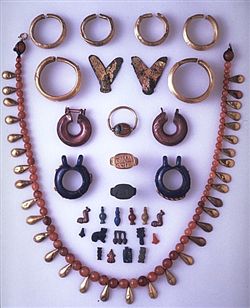
Jewellery was worn in ancient Egypt from prehistoric times, for many different reasons. Many pieces of jewellery were primarily amulets, and were often made from materials considered to have a protective character. The aim of decorating the body also played a role, as well as the need to indicate social status by wearing jewellery. Information can not only be gained from statues displaying jewellery and from illustrations on tomb walls, but especially from finds of actual jewellery. Sadly the number of finds is limited because many tombs were plundered in antiquity. From prehistoric times we know of glazed stone beads (Badari period), faience beads and ivory bracelets. Jewellery of lapis lazuli, turquoise, amethyst and gold survives from the early Dynastic period. The artefacts from the tomb of Hetepheres also included silver jewellery. The treasures of several Middle Kingdom princesses have been found in their tombs at Dahshur, Lahun and Lisht. The best known jewellery from the New Kingdom includes that of Ahhotep, that of three wives of Tuthmosis III, of Tutankhamun and of Khaemwaset, a son of Ramesses II. Jewellery belonging to various kings of the Third Intermediate Period was found in their tombs at Tanis. Not only royal jewellery has been found, we also have many examples of jewellery that belonged to ordinary people. This consists in the main of semi-precious stones, faience and glass. Statues of the gods were also decorated with jewellery. Jewellery was not only worn during life but also accompanied the deceased to the afterlife. Some of it was specially made for the tomb, as demonstrated by the lack of a clasp, the fragility of some pieces, and the typical funerary motifs used as decoration.